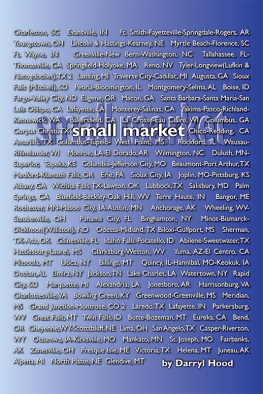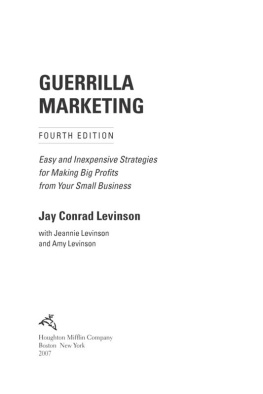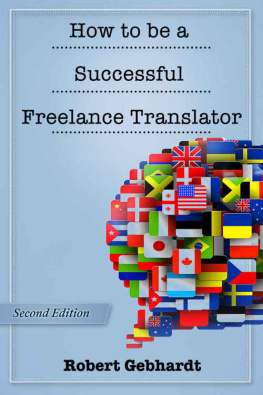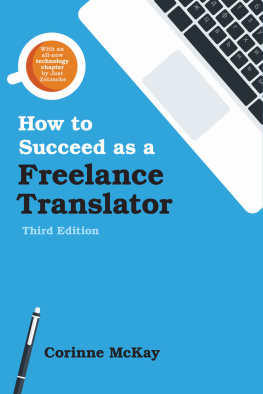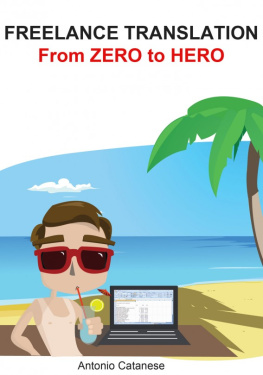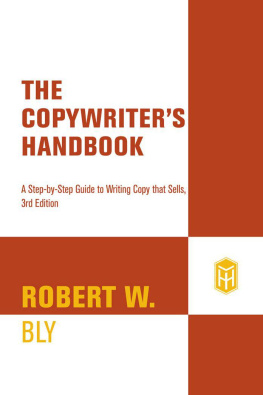
Disclaimer: This book is published by Two Rat Press and Translatewrite, Inc., who acknowledge all trademarks. All information contained in this book is believed to be correct at the time of printing. However, readers are advised to seek professional advice where necessary, as the information in this book is based on the authors experiences. The author of this book is not professionally engaged in providing legal, financial or career planning advice. Please send comments or corrections to corinne@translatewrite.com.
2015 by Corinne McKay. All Rights Reserved. No part of this book may be reproduced or transmitted in any form or by any means, electronic or mechanical, including photocopying, recording, or by any information storage or retrieval system, except by a reviewer who may quote brief passages in a review, without permission in writing from the author. ISBN: 978-0-578-17007-7 eISBN: 978-1-483-56339-8
Contents
Acknowledgments
Introduction to the third edition
1 A quick start guide to freelance translation
1.1 Who can become a freelance translator?
1.2 Translator certification
1.3 Interpreter certification
1.4 Clients
1.5 Your range of services
1.6 Pricing and income potential
1.7 What you need to get started
1.8 Tax and legal issues
1.9 Your first year as a freelancer
2 Myths and truths about freelance translation
3 An overview of the translation business
3.1 What is a translator?
3.2 What does it take to become a translator?
3.3 Why do some freelance translators fail?
3.4 Improving your language skills
3.5 A translators working environment
3.6 What kinds of work do translators do?
3.6.1 Translation
3.6.2 Editing
3.6.3 Proofreading
3.6.4 Voiceover
3.6.5 Transcription
3.6.6 On-site document review
3.6.7 Machine translation post-editing
3.6.8 Software Localization
3.7 Who do translators work for?
3.7.1 Working for translation agencies
3.7.2 Working for direct clients
3.8 Agencies vs direct clients
3.8.1 Working with individuals
3.9 A bit about interpreting
3.10 How do translators set their rates?
3.10.1 Charging by the word versus charging by the hour
3.11 Professional Associations
3.11.1 American Translators Association
3.11.2 National Association of Judiciary Interpreters and Translators
3.11.3 American Literary Translators Association
3.11.4 Fdration Internationale des Traducteurs
3.11.5 International Association of Conference Interpreters
3.12 Certification for Translators
3.12.1 American Translators Association
3.12.2 Federal Court Interpreter Certification Examination Program
3.12.3 State Court Interpreter Certification
4 Launching your freelance translation business
4.1 The start-up phase
4.2 Ways to start
4.3 The start-up checklist
4.4 Preparing to market your services
4.4.1 The basics of writing a translation resume.
4.4.2 A new resume for a new career
4.4.3 The structure of your resume
4.4.4 Your name
4.4.5 Your tag line
4.4.6 Your contact information
4.4.7 Your objective
4.4.8 Your summary of qualifications
4.4.9 The body of the rsum
4.4.10 The professional/related experience section
4.4.11 The education section
4.4.12 The professional development and memberships section
4.4.13 The computer skills and equipment section
4.4.14 The interests and activities section
4.4.15 What about a cover letter?
4.5 Finding your first clients
4.6 Building up your business
4.7 Starting a part-time translation business
4.8 Business skills youll need
5 Setting up your office and your business
5.1 The ups and downs of working from home
5.2 Communication devices and services
5.3 Reference materials
5.4 Office setup
5.5 Organizing your business
5.6 Maximizing productivity
5.7 For working parents
6 Marketing your freelance services
6.1 Marketing to translation agencies
6.1.1 Finding agencies to apply to
6.1.2 Optimizing your application materials
6.1.3 Keeping track of your contacts
6.1.4 Following up on your contacts
6.2 Marketing to direct clients
6.2.1 Identifying your target clients
6.2.2 Using your existing network
6.2.3 Expanding your network
6.2.4 International business organizations
6.2.5 Your local business news
6.2.6 Trade publications
6.3 Making contact with potential direct clients
6.3.1 Highly personalized e-mails
6.3.2 Attending conferences and trade fairs
6.3.3 Networking and referrals
6.3.4 A website in your clients language
6.3.5 Paper letters and postcards
6.3.6 LinkedIn groups
6.3.7 Free sample translations
6.3.8 Advertising
6.4 Making yourself findable
6.5 Marketing materials
6.6 Creating a website
6.7 Ten ways to please a translation client
7 Breaking into the direct client market
7.1 Why consider working with direct clients?
7.2 Potential drawbacks of working with direct clients
7.3 The direct client marketing mindset
7.4 If you dont know where to start
7.5 Untapped niches
8 Translation Technology
8.1 The bare necessities
8.2 What kind of computer?
8.3 Speech recognition
8.4 Which operating system?
8.5 What else?
8.5.1 Searching
8.5.2 Renaming files
8.5.3 Dealing with PDFs
8.5.4 Project Management/Invoicing
8.5.5 Word counts
8.6 Translation environment tools
8.6.1 Wordfast Classic
8.6.2 memoQ
8.6.3 Trados Studio
8.6.4 OmegaT
8.6.5 Memsource
8.6.6 How to choose the right Translation Environment Tool
8.7 Machine Translation
9 Your online presence
9.1 Setting up a basic professional website
9.1.1 Cost
9.1.2 Buying a domain name
9.1.3 Setting up website hosting
9.1.4 Using domain name e-mail
9.2 Listserves and e-mail discussion lists
9.3 Online forums
9.4 Social networking sites
9.4.1 LinkedIn
9.4.2 Facebook
9.4.3 Twitter
9.4.4 Blogs
9.4.5 Podcasts
9.4.6 Pinterest and Instagram
10 Rates, contracts and terms of service
10.1 Setting your translation rates
10.1.1 Gathering objective data about rates
10.2 Charging by the word versus charging by the hour 176 10.3 Rate sheets
10.4 When a client asks for a discount
10.5 Contracts or work for hire agreements
10.6 Terms of service
10.7 Questions to ask before accepting a project
10.8 Researching your potential clients
10.8.1 Handing potentially problematic clients
10.8.2 Recourse against non-paying clients
10.9 Payment terms and methods
10.10 International payments
10.10.1 Wire transfer
10.10.2 Foreign currency checks
10.10.3 Overseas bank accounts
10.10.4 PayPal
10.10.5 TransferWise
10.11 Setting the stage for payment
10.12 When things dont go as planned
10.12.1 Arbitration and dispute resolution
10.13 Cash flow issues
11 Research tools and methods
11.1 Sources for printed dictionaries
11.2 Web-based research tools
11.3 Installed electronic dictionaries
11.4 What to research
Next page
![Korinn MakKej How to Succeed as a Freelance Translator [calibre 3.46.0]](/uploads/posts/book/876928/thumbs/korinn-makkej-how-to-succeed-as-a-freelance.jpg)


